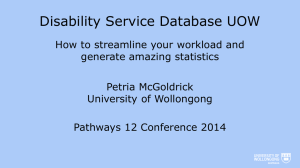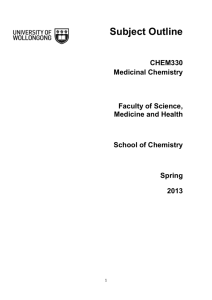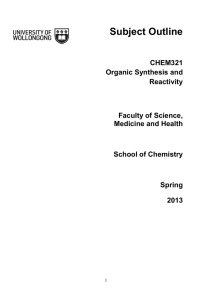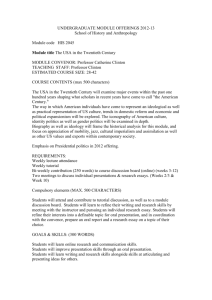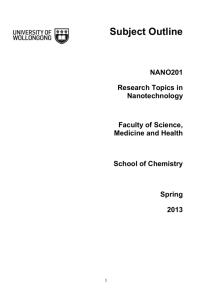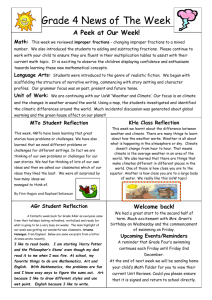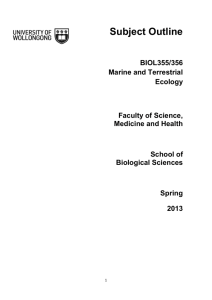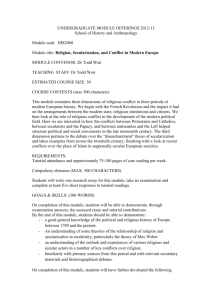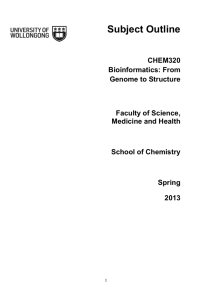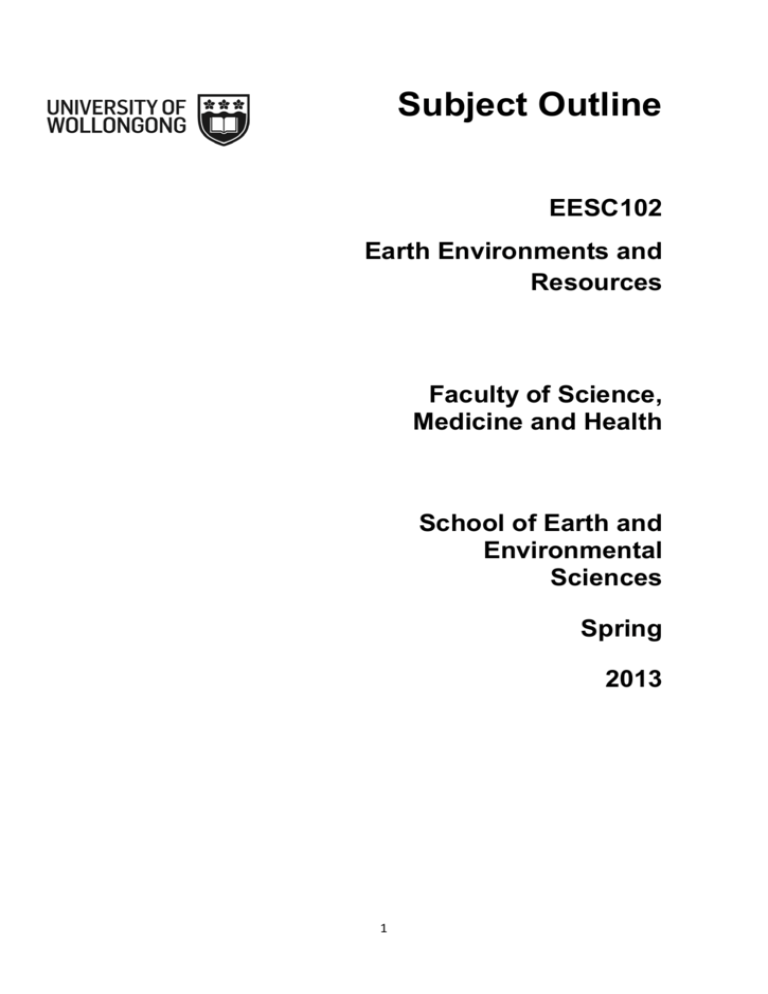
Subject Outline
EESC102
Earth Environments and
Resources
Faculty of Science,
Medicine and Health
School of Earth and
Environmental
Sciences
Spring
2013
1
Subject Outline
Subject code:
EESC102
Subject name:
Earth Environments and Resources
Credit points:
6
Pre/co-requisites:
None
Mode of delivery:
On Campus
Delivery location:
Wollongong
Version history
2nd edition
Brian G Jones , Faculty of Science, Medicine and Health , UOW
2013
1 edition
Brian G Jones , Faculty of Science, Medicine and Health , UOW
© University of Wollongong 2013. All rights reserved.
2009
st
Copyright and Disclaimer
No part of this work may be reproduced without the prior written consent of the University of Wollongong. All requests and
enquiries should be directed to the Vice-Principal (Administration), University of Wollongong, Northfields Avenue, Wollongong
NSW 2522 Australia. Within Australia telephone (02) 4221 3920; international +61 2 4221 3920.
http://www.uow.edu.au/about/disclaimer/index.html
The University of Wollongong attempts to ensure that the information contained here is correct at the time of production,
however, sections may be amended without notice by the University in response to changing circumstances or for any other
reason.
2
Contacts
Subject Co-ordinator
Name:
A. Prof. Brian G Jones
Faculty of Science, Medicine and Health
Location
41.152
Telephone
Email
61 2 4221 3492
smah_student_enquiries@uow.edu.au
Consultation mode and times:
_________________________________________________________________________
Lecturers/Tutors/
Demonstators
Office
Phone
Email
Consultation times
Brian Jones
41.168A
3803
briangj@uow.edu.au
Wed 1.30-3.30 pm
Sol Buckman
41.163
5950
solomon@uow.edu.au
Tues 2-4 pm
Megan Williams
41.158
5369
meganw@uow.edu.au
Wed 1.30-3.30 pm
3
Subject Information
Outline
EESC102 is intended to give an appraisal of depositional environments, fossils, natural
hazards and resources in the Earth’s crust. Depositional sequences are investigated in
terms of sedimentary features and the contained fossils. Fossils are also used to determine
the relative age of sedimentary successions and the geological evolution of eastern
Australia. Natural hazards caused by geological processes are introduced. Resource topics
include investigation of fossil fuels, especially coal and petroleum, as well as sedimentary,
igneous and metamorphic metalliferous deposits and industrial materials. This subject also
considers the implications of resource utilisation and its environmental consequences.
Learning Outcomes
Through successful completion of this subject students will be able to:
1. understand the main groups of fossils and their environmental significance;
2. describe and identify common fossils, rocks and ore minerals;
3. describe and identify common sedimentary successions;
4. be aware of natural geological hazards;
5. understand geological maps and structures and assess economic deposits;
6. describe and understand the basic principles of ore genesis; and
7. describe and understand the environmental implications of ore extraction and
processing.
Faculty Graduate Qualities
Valuable qualities gained by UOW graduates are essential for gaining employment and
making an important contribution to society and their chosen field – further information is
available at http://www.uow.edu.au/about/teaching/qualities/
Engagement in this subject will contribute to each student’s development of the following
UOW Graduate Qualities:
Informed
• Comprehensive knowledge of an area of Science and well-developed skills in using
relevant technologies
• Awareness of the international context in which advances in Science are made and
applied
Independent learners
• Critical thinking skills
• Scientific approach to the acquisition, analysis, and interpretation of data
Independence in seeking to extend knowledge through ongoing research, enquiry and
reflection
• Problem solvers
• Application of creative, logical and critical thinking to scientific problems
4
Effective communicators
• Well-developed written, oral & aural communication
• Effective collaboration and teamwork across a range of settings and cultures
Responsible
• Ethical decision making
• Respect for diverse opinions, professions, and cultures
5
Lecture/Tutorial/Laboratory Times
Refer to http://www.uow.edu.au/student/timetables/index.html for an up-to-date timetable.
Wollongong Campus
Class
Day and time
Room
Lecture 1
Monday 14.30 – 15.30
20.3
Lecture 2
Monday 15.30 – 16.30
20.3
Practical
Wednesday 9.30 - 12.30
41.153
OR Thursday 8.30 - 11.30
41.153
OR Thursday 11.30 - 14.30
41.153
OR Thursday 14.30 – 17.30
41.153
A compulsory field tutorial to Sandon Point, Bulli will be held on Saturday 31 August or
Sunday 1 September.
Attendance at all lectures is very strongly recommended; attendance at practical classes and
the field tutorials is compulsory. ALL lecture and practical material is examinable.
Each student will be allocated to a practical class and may not change to another class
without the prior approval of the subject coordinator. Practical work is an integral part of the
subject and cannot be replaced by work outside the laboratory; the practical exercises are
designed to reinforce and explain some lecture topics and to introduce some topics not
covered in the lectures. Attendance at practical classes is compulsory as outlined under the
assessment requirements for the subject.
Students are EXPECTED to read the appropriate lecture and practical notes BEFORE class.
Lectures are designed to explain, expand on and give examples of specific topics in the
notes rather than to repeat the printed notes. Similarly, preparation for each practical class
by studying the appropriate notes will ensure efficient and meaningful completion of the
practical exercises.
On the Friday following each practical class, solutions to practical exercises will be available
on the eLearning space.
The compulsory field tutorials are an essential part of EESC102 and provide the opportunity
for students to recognise and interpret, in the field, some of the geological features studied in
lectures and practical classes. The field tutorial will be held at Sandon Point, Bulli, and
students will need to provide their own transport. Bulli has a railway station and the field
tutorial will be organised, if possible, to accommodate the train timetable. More information
will be provided closer to the time of the tutorial.
The theory examination is scheduled centrally and a timetable is released to students via
SOLS midway through the session. Students are expected to be available to sit any
examination up to and including the last day of the scheduled examination period. For
security and equity reasons, it is not possible to schedule an examination for individuals
before the scheduled date. Rescheduling of an examination after the scheduled date is only
permitted when a student has been affected by one of the circumstances outlined in the
Special Consideration Policy. Holidays, returning home overseas beforehand, and weddings
are not legitimate circumstances listed in this policy.
6
Study Time
Students should note that UOW policy equates 1 credit point with 2 hours of study per week
that includes lectures and tutorials. For example, in a 6 credit point subject, a total of 12
hours of study per week is expected.
Formal class hours for EESC102 comprise two (2) hours of lectures and three (3) hours of
compulsory practical class per week, together with one (1) day of compulsory field tutorial to
be held on either Saturday 31 August or Sunday 1 September.
Prescribed Reading
No text is prescribed for the subject. Lecture notes are available for purchase (cost $25.00)
at classes during the first week of Session. All students are issued with a laboratory manual.
Recommended Readings
Huddart, D. and Stott. T., 2010. Earth Environments: Past, Present and Future. WileyBlackwell, Chichester, UK
Montgomery, C.W., 2008. Environmental Geology, 8th Ed. McGraw-Hill, Boston.
Many other introductory geology texts are equally useful as general reading. Other
references (including web addresses) will be supplied, as appropriate, during the subject.
The recommended readings are not intended as an exhaustive list and students should use
the Library catalogue and databases to locate additional resources.
Materials
Equipment recommended for practical classes and the field tutorial:
1. appropriate enclosed footwear must be worn in the laboratory; NO bare feet, thongs or
open-toed shoes (e.g. sandals) are permitted
2. drawing instruments (ruler, eraser, pencils, pens, etc.)
3. hand lens or magnifying glass (preferably x10 or x8)
4. day pack, water bottle, hat, sunglasses and sunscreen for field tutorial
5. sturdy footwear (boots or joggers) for field tutorial
6. clipboard for field tutorial
e-Learning
This subject has materials and activities available via eLearning. To access eLearning you
must have a UOW user account name and password, and be enrolled in the subject.
eLearning is accessed via SOLS (student online services). Log on to SOLS and then click on
the eLearning link in the menu column.
For information regarding the eLearning spaces please use the following links:
Blackboard Vista - http://www.uow.edu.au/student/elearning/vista/index.html.
Moodle - http://uowblogs.com/moodlelab/files/2013/05/Moodle_StudentGuide-1petpo7.pdf
7
Lecture Schedule or Topic List
See Timetable on e-Learning
Assessment
Minimum attendance requirements
Attendance at laboratory classes is compulsory. Students who fail to attend at least ten
(10) of the twelve (12) practical classes will be awarded a fail grade for the subject.
"Attendance" will be construed as evidence of completion of the practical exercises for the
class or attendance for the whole three-hour session. A record of attendance will be kept.
Laboratory and field footwear. Students must wear appropriate footwear in the laboratory
and in the field; no bare feet, thongs or open-toed shoes (e.g. sandals) are permitted.
Attendance at the Sandon Point, Bulli, field tutorial is compulsory. Failure to
complete this part of the subject will result in a fail or technical fail grade being
awarded.
Minimum performance requirements
Students need to complete each component at the level specified.
Component
Final Examination
Practical Examination
Essay
Field tutorials
Minimum Standard
40% of available marks
40% of available marks
40% of available marks
Completion of two field
tutorial tests
Completion of four tests
Practical tests
Students who do not meet the minimum performance requirements as set out in the Subject
Outline may be given a Fail grade or TF (Technical Fail) grade on their Academic Transcript.
See the General Course Rules at
http://www.uow.edu.au/handbook/generalcourserules/index.html
8
Summary
Task
1
2
3
4
5
6
7
8
9
Title
Flagstaff Point field
tutorial test
Practical test 1
Sandon Point field
tutorial test
Practical test 2
Practical test 3
Essay
Practical test 4
Practical Examination
Theory Examination
Weighting
4%
Due Date
During practical class in week 2
4%
5%
During practical class in week 3
Saturday 31 August or Sunday 1
September
During practical class in week 6
During practical class in week 8
Friday 27 September, week 9
During practical class in week 10
During practical class in week 13
November examination period
4%
4%
10%
4%
25%
40%
Performance grades
HD
High Distinction
85–100%
D
Distinction
75–84%
C
Credit
65–74%
P
Pass
50–64%
PS
Pass Supplementary
50%
F
Fail (unsatisfactory completion)
0–49%
TF
Technical Fail
No mark recorded
Scaling
Marks awarded for any assessment task (including examinations) may be subject to scaling
at the end of the session by the Unit Assessment Committee and/or the Faculty Assessment
Committee (FAC). Marks will only be scaled to ensure fairness/parity of marking across
groups of students. Scaling will not affect any individual student’s rank order within their
cohort. For more information refer to Assessment Guidelines – Scaling
http://www.uow.edu.au/about/policy/UOW058609.html
Submission and Return of Assessment Items
Field and Practical tests
Field and practical tests will be collected at the end of the test and marked tests will be
returned in the practical classes usually within one week of the test.
Essay
Select one of the essay topics listed in the essay section of eLearning and prepare a 2000
word essay. Notes on essay writing are attached in eLearning. READ THEM CAREFULLY.
A hard copy of the essay must be submitted through SMAH Central by 2.30 pm on Friday
27 September and must have a SATS Assignment Coversheet attached to the essay.
9
Marked essays will be returned through SATS approximately two weeks after the due date.
Uncollected assessment tasks will be destroyed 21 days after the release of marks for
Spring session.
Students are advised to keep an electronic or hard copy of all submitted assessment tasks
except in circumstances where this is not possible e.g. where the task is submitted at the
end of activity in which it was completed.
Submitting an assignment at SMAH Central
Assignments submitted at SMAH Central MUST have a SATS (Student Assignment
Tracking System) coversheet attached to the front of the assignment. Instructions for
generating a coversheet can be found on the SMAH Central web page.
For an assignment to be successfully submitted at SMAH Central please note the following:
•
•
•
•
The coversheet must be signed and dated
The assignment must have the correct coversheet i.e. the correct subject code and
tutorial group (if applicable)
A legible barcode with all numbers and digits below e.g. UOW20121007656
Assignments must be submitted by 2.30pm on the due date
If an assignment is submitted to SMAH Central without any of the above we will contact you
and advise that you need to return to SMAH Central with the correct coversheet. Your
assignment won’t be recorded as being submitted until the correct coversheet is attached.
This might mean that the assignment is recorded as being submitted late.
Late Submission
All assessment tasks are to be submitted on the due dates as specified in this Subject
Outline. Assessment tasks submitted late will be penalised by the deduction of 10% of the
maximum possible mark for the assessment task per calendar day or part thereof. Deduction
of marks will not result in a negative mark.
Note that assessment tasks submitted to SMAH Central must be submitted by 2:30 pm on
the due date to guarantee being recorded in SATS as being submitted on time.
Academic Consideration including Extensions of Time
Applications from students for academic consideration should be made only on the grounds
of serious or extenuating circumstances. Applications for academic consideration are
governed by the University’s Student Academic Consideration Policy at
http://www.uow.edu.au/about/policy/UOW058721.html
Do not assume that an application for special consideration will be automatically granted.
Supplementary Assessments
Supplementary assessment may be offered to students who receive a mark of 48% or 49%,
and are otherwise identified as meriting an offer of a supplementary assessment. The form
10
of supplementary assessment will be determined at the time the offer of a supplementary
assessment is made. For more information refer to the Supplementary Assessment
Guidelines
http://www.uow.edu.au/content/groups/public/@web/@gov/documents/doc/uow112335.pdf.
Note that if you are offered a supplementary examination as the supplementary assessment
that you will need to sit the examination in the supplementary examination period.
Referencing
The Harvard referencing system is used in EESC102 – this is also known as the author-date
system due to the order of the information presented. Failure to document adequately and
fully is to ignore scholarly rules – and run the risk of plagiarism.
Please
consult
the
UOW
library
website
for
further
information:
http://public01.library.uow.edu.au/refcite/style-guides/html/
Plagiarism
Students are responsible for submitting original work for assessment, without plagiarising or
cheating, abiding by the University’s policy on plagiarism as set out in the University
Handbook under the University’s Policy Directory. Plagiarism has led to expulsion from the
University.
The University’s Academic Integrity and Plagiarism Policy, Faculty Handbooks and subject
guides clearly set out the University’s expectation that students submit only their own original
work for assessment and avoid plagiarising the work of others or cheating. Re-using any of
your own work (either in part or in full) which you have submitted previously for assessment
is not permitted without appropriate acknowledgement. Plagiarism can be detected and has
led to students being expelled from the University.
The use by students of any website that provides access to essays or other assessment
items (sometimes promoted as ‘resources’) is extremely unwise. Students who provide an
assessment item (or provide access to an assessment item) to others, either directly or
indirectly (for example by uploading an assessment item to a website) are considered by the
university to be intentionally or recklessly helping other students to cheat. This is considered
academic misconduct and students place themselves at risk of being expelled from the
University.
http://www.uow.edu.au/about/policy/UOW058648.html
11
Assessment Tasks
_________________________________________________________________________
Task 1:
Due Date:
Weighting:
Details:
Criteria for assessment:
Flagstaff Point Field Tutorial Test
During practical class in week 2
4%
Short answer questions
provision of correct answers
Task 2:
Due Date:
Weighting:
Details:
Criteria for assessment:
Practical Test 1
During practical class in week 3
4%
Short answer questions
provision of correct answers
Task 3:
Due Date:
Weighting:
Details:
Criteria for assessment:
Sandon Point Field Tutorial Test
Saturday 25 August or Sunday 26 August (end week 5)
5%
Short answer questions
provision of correct answers
Task 4:
Due Date:
Weighting:
Details:
Criteria for assessment:
Practical Test 2
During practical class in week 6
4%
Short answer questions
provision of correct answers
Task 5:
Due Date:
Weighting:
Details:
Criteria for assessment:
Practical Test 3
During practical class in week 8
4%
Short answer questions
provision of correct answers
Task 6:
Due Date:
Weighting:
Details:
Essay
Friday 27 September, week 9
10%
Select one of the essay topics listed in the essay section of
eLearning and prepare a 2000 word essay. Notes on essay
writing are attached in eLearning. READ THEM CAREFULLY.
evidence of knowledge and understanding of the topic and use
of appropriate format, examples, diagrams and references
Criteria for assessment:
Task 7:
Due Date:
Weighting:
Details:
Criteria for assessment:
Practical Test 4
During practical class in week 10
4%
Short answer questions
provision of correct answers
Task 8:
Due Date:
Weighting:
Details:
Criteria for assessment:
Practical Examination
During practical class in week 13
25%
Short answer questions, maps and diagrams
provision of correct answers
12
Task 9:
Due Date:
Weighting:
Details:
Criteria for assessment:
Theory examination
During examination period in November
40%
Essay and short answer questions
evidence of knowledge and understanding of the topic and
reference to approprite examples and diagrams
General Advice
Students should refer to the Faculty of Science, Medicine and Health website for information
on policies, learning and support services and other general advice.
Use of Electronic Devices in Timetabled Activites
Ensure that mobile phones are turned off or turned to silent before timetabled activities.
Electronic devices including mobile phones and portable MP3 players should not be
accessed during timetabled activities unless otherwise advised.
13

